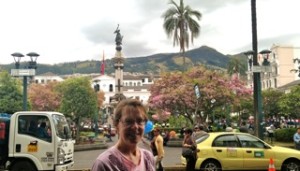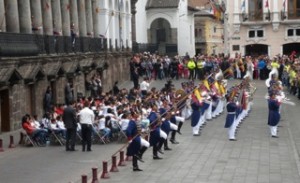Ecuador is an exciting destination. Located on the equator of South America, the country is composed of four major regions that are all easily accessible. Colonial cities of the highlands, Amazon Rainforest. Mountains and Pacific coast beaches to the Galapagos Islands. The weather is springtime year round and the people with their rich culture and traditions are warm and friendly.
Quito, Ecuador’s capital was founded on the ruins of an Incan City and is stunning in its 16th century churches and modern festivals. The city sprawls across a breathtaking Andean Valley surrounded by volcanic peaks. It remains the least-altered historic center in Latin America and has been designated a UNESCO World Heritage Site.
The city center is Plaza de la Independencia or ” Plaza Grande”. The simple, original Cathedral, the bishop’s palace, and the President’s residence surround this square full of flowers and shrubs. This is one of the most alive squares you will ever visit with local color everywhere.
Monday is the changing of the guard ceremony at the Presidential Place located on the square.
There is an appearance by the Ecuadorian President, VP, and many other local dignitaries. Lots of pomp and circumstance with sword bearing guards and guards on horseback, all dressed in elaborate uniforms. As the national anthem is sung, the Ecuadorian flag is raised over the palace. Make sure to arrange your stay in Quito for a Monday.
The most noteworthy attractions to this city are the three main churches all within walking distance in the old city. The Iglesia de La Compañía de Jesus church is a masterpiece of baroque and Quiteno-colonial art with lavish golden altars and gilded columns, making this one of the most ornate structures in Ecuador.
Sitting on a hillside overlooking the city of Quito is the statue, “La Virgin del Panecillo”. The steep drive up is equally as interesting and one will see a different side of Quito with breathtaking views awaiting you at the top.
Calle La Ronda – will capture the feeling of Quito in the 1800’s. This quaint, cobblestone street covers just a couple of city blocks, easing its way up a hill edged with remembrances of Quito’s Spanish heritage—old wood doors that open to reveal a plant-filled patio, burbling fountains and thick plastered wall.
 Solid stone entryways and wide stone steps contrast with delicate ironwork. Baskets of flowers and colorful flags hang from the walls and balconies. This pedestrian-only promenade can be rather sleepy during the daytime, but at night La Ronda comes alive! Live music spills out of tiny bars onto the cobbled street and aromas of local delicacies mingle in the air. Each evening here feels like a celebration of Quito’s grand past.
Solid stone entryways and wide stone steps contrast with delicate ironwork. Baskets of flowers and colorful flags hang from the walls and balconies. This pedestrian-only promenade can be rather sleepy during the daytime, but at night La Ronda comes alive! Live music spills out of tiny bars onto the cobbled street and aromas of local delicacies mingle in the air. Each evening here feels like a celebration of Quito’s grand past.
La Ronda, which means “small alleyway”, has an old and storied past. It was once an ancient footpath for locals to access the nearby Pichincha River during Pre-Incan times. It became the lively heart of the city after the Spanish left a legacy of art and architecture here. In the early 1900’s, La Ronda was known as the bohemian center of Quito, and it’s thriving night scene was frequented by the city’s poets, painters, writers and musicians.
Plaza Andaluz Hotel in the city center, just 1/2 a block from Plaza Grande is a charming boutique hotel. The hotel occupies two patios of an old Quito mansion, one behind the other, comprising the former residence of the 17th–century Marqués de Jerez and a string of noble families down the centuries. The adaptation of the buildings was intelligently done, covering the patios with glass roofs.

While the Patio Andaluz is a very good value, the Plaza Grande Hotel directly on the Plaza Grande or the less ideally located Mansiondel Angel, are a step up in service and style.


